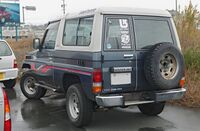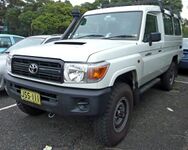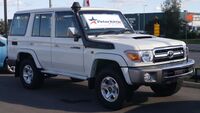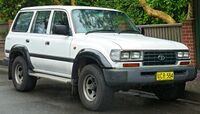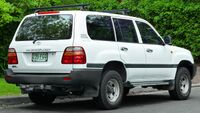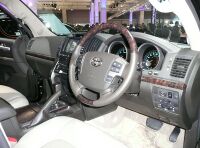Engineering:Toyota Land Cruiser
| Toyota Land Cruiser | |
|---|---|
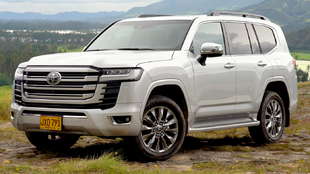 2021 Toyota Land Cruiser ZX (VJA300, Colombia) | |
| Overview | |
| Manufacturer | Toyota |
| Production | 1951–present |
| Body and chassis | |
| Class |
|
| Layout | Front-engine, four-wheel-drive |
The Toyota Land Cruiser (Japanese: トヨタ・ランドクルーザー Hepburn: Toyota Rando-Kurūzā) (/lənd kruɪzʁ/) (also sometimes spelled as LandCruiser)[1] is a series of four-wheel drive vehicles produced by the Japanese automobile manufacturer Toyota. It is Toyota's longest running series of models.[2] (As of 2019), the sales of the Land Cruiser totalled more than 10 million units worldwide.[3]
Production of the first generation of the Land Cruiser began in 1951.[3][4][5] The Land Cruiser has been produced in convertible, hardtop, station wagon and cab chassis body styles. The Land Cruiser's reliability and longevity have led to huge popularity, especially in Australia, where it is the best-selling body-on-frame, four-wheel drive vehicle.[6] Toyota also extensively tests the Land Cruiser in the Australian outback – considered to be one of the toughest operating environments in both temperature and terrain.[7][8][9] In Japan, the Land Cruiser was once exclusive to Toyota Japanese dealerships called Toyota Store.
Since 1990, the smaller variation of the Land Cruiser has been marketed as the Land Cruiser Prado. Described as a 'light-duty' version of the Land Cruiser by Toyota, it features a different design compared to the full-size model and, up until 2023, it remains the only comfort-oriented Land Cruiser available with a short-wheelbase 3-door version.
As of 2023, the full-size Land Cruiser was available in many markets. Exceptions include the United States (since 2021),[10] Canada (since 1996),[11] Malaysia (which receives the Lexus LX instead), Hong Kong, Macau, South Korea, Brazil, and most of Europe. In Europe, the only countries where the full-size Land Cruiser is officially sold are Gibraltar, Moldova, Russia, Belarus and Ukraine. The Land Cruiser is hugely popular in the Middle East, Russia, and Australia, and also in Africa where it is used by farmers, the construction industry, NGO's, UN and humanitarian organizations, by national armies (often the pickup version) as well as by irregular armed groups who turn them into 'technicals' by mounting machine guns in the rear. In August 2019, cumulative global sales of the Land Cruiser family surpassed 10 million units.[12]
Origin
In 1936, the Imperial Japanese Army introduced the Kurogane Type 95 four wheel drive reconnaissance car. However, in a separate development, in 1941, the Japanese government asked Toyota to develop a light truck for the military. And after the Empire of Japan occupied the Philippines , during 1941–1942, a captured Bantam GP (or Willys MB) was sent to Japan for assessment and testing. Japanese military authorities subsequently requested that Toyota produce a similar vehicle, albeit with an altered external appearance.
The prototype Model AK led to the Yon-Shiki Kogata Kamotsu-Sha (四式小型 貨物 車 type 4 compact cargo-truck).[13] The half-ton truck featured an upright front grille, flat front wheel arches that angled down and back (like the later FJ40), headlights mounted above the wheel arches on either side of the radiator, and a folding windshield.
Production AK10 vehicles were powered by the 2,259 cc (2.3 L), 4-cylinder Type C engine from the Toyota Model AE sedan coupled to a three-speed manual transmission and a two-speed transfer gearbox. Unlike the U.S. Jeep, the AK10 had limited use and photographs of it in the battlefield are rare.
In June 1954, responding to claims of trademark violation by the Willys Company that produced the original Jeep, then Director of Technology Hanji Umehara renamed the vehicle "Land Cruiser."
The postwar Toyota "Jeep" BJ is completely different from the AK10 and inherits no mechanical parts from it. However, a lot of lessons learned while developing the AK10 were applied when developing the BJ.[14]
Lineage
Toyota divided the Land Cruiser family into three series.[15] The most basic version is the 'heavy-duty' series, which prioritizes functionality, durability and off-road capabilities over comfort or technology. It is also characterised by flatter steel body panels and a near vertical greenhouse. Models considered as 'heavy-duty' by Toyota are the BJ, FJ, 20, 40 and 70 series.[16]
The 'station wagon' series of the Land Cruiser has more emphasis on comfort and interior space. The 'station wagon' series first appeared in 1967 as the 55 series Land Cruiser Station Wagon, which was conceived as a four-wheel drive vehicle for recreational use with sufficient space to carry an entire family – a format that was popular with customers in the U.S. Models considered as part of the 'station wagon' series are the 55, 60, 80, 100, 200, and 300 series.[17]
Since the 70 series, the 'light-duty' series has been offered. Primarily tuned for the European market, it was intended to be a more comfortable version of the 'heavy-duty' series by adopting coil spring suspension, while being smaller and more affordable than the 'station wagon' series. Since 1990, the 'light-duty' series gained an additional moniker for some markets, Prado, coinciding with the release of the 90 series Land Cruiser that was designed to be more comfort oriented. 'Light-duty' models included the 70 wagon, 90, 120, 150 and 250 series.[15]
Availability of these series varies by market. Until 2021, the U.S. and Canada received the 'station wagon' model, but switched to the smaller 'light-duty' model with the release of the 250 series in 2023.[18] Most of Europe received the 'light-duty' model, while only several European countries also received the 'station wagon' model.[19]
| Timeline of the Toyota Land Cruiser, 1951–present[20] |
|---|
| <timeline>DateFormat=dd/mm/yyyy
Define $start = 01/01/1950 Define $now = 13/07/2024 Define $later = 13/07/2028 Define $skip = at:end # Force a blank line Define $dayunknown = 15 # what day to use if it's actually not known Period = from:$start till:$later ImageSize= width:1000 height:auto barincrement:20 TimeAxis = orientation:horizontal PlotArea = right:1 left:1 bottom:100 top:1 Colors = id:bg value:white id:70l value:rgb(0.7,0.9,0.5) id:90 value:rgb(0.6,0.85,0.5) id:120 value:rgb(0.5,0.80,0.5) Legend:Light-duty_(Prado) id:150 value:rgb(0.4,0.75,0.5) id:250 value:rgb(0.3,0.7,0.5) id:linem value:rgb(0.9,0.9,0.9) id:liney value:rgb(0.5,0.5,0.5) id:bj value:rgb(0.7,0.80,0.8) id:20 value:rgb(0.6,0.75,0.8) id:40 value:rgb(0.5,0.70,0.8) Legend:Heavy-duty id:70 value:rgb(0.4,0.65,0.8) id:50 value:rgb(1 ,0.9,0.4) id:60 value:rgb(0.98,0.85,0.4) id:80 value:rgb(0.96,0.80,0.4) id:100 value:rgb(0.94,0.75,0.4) Legend:Station_wagon id:200 value:rgb(0.92,0.70,0.4) id:300 value:rgb(0.90,0.65,0.4) id:current value:rgb(0.9,0.9,0.9) Legend:Still_produced BackgroundColors = canvas:bg ScaleMajor = gridcolor:liney unit:year increment:4 start:01/01/1950 ScaleMinor = gridcolor:linem unit:year increment:1 start:01/01/1951 Legend = orientation:horizontal position:bottom BarData = barset:lightduty1 barset:heavyduty1 barset:heavyduty2 barset:heavyduty3 barset:stationwagon1 barset:stationwagon2 PlotData = width:15 textcolor:black shift:(5,-5) anchor:from fontsize:s barset:lightduty1 color:90 from:01/04/1990 till:15/05/1996 text:"J70" barset:break color:150 from:16/05/1996 till:15/10/2002 text:"J90" barset:break color:90 from:16/10/2002 till:15/08/2009 text:"J120" barset:break color:150 from:15/09/2009 till:15/08/2023 text:"J150" barset:break color:90 from:15/08/2023 till:$now text:"J250" barset:break color:current from:$now till:end barset:heavyduty1 color:bj from:15/08/1951 till:15/01/1965 text:"BJ" barset:heavyduty2 color:40 from:15/11/1955 till:15/12/1959 text:"J20" barset:break color:bj from:15/08/1960 till:15/10/1986 text:"J40" barset:heavyduty3 color:40 from:15/11/1984 till:$now text:"J70" barset:break color:current from:$now till:end barset:stationwagon1 color:200 from:15/08/1967 till:15/07/1981 text:"J50" barset:stationwagon1 color:80 from:15/08/1980 till:15/01/1990 text:"J60" barset:stationwagon2 color:80 from:15/10/1989 till:15/01/1998 text:"J80" barset:break color:200 from:16/01/1998 till:15/08/2007 text:"J100" barset:break color:80 from:15/09/2007 till:15/03/2021 text:"J200" barset:break color:200 from:16/03/2021 till:$now text:"J300" barset:break color:current from:$now till:end </timeline> |
Light Duty series
Heavy Duty series
BJ and FJ (1951)
| BJ and FJ | |
|---|---|
| Overview | |
| Also called | Toyota Jeep BJ (1951–1954) |
| Production | 1951–1955 |
| Assembly | Toyota City, Japan (Arakawa Auto Body) |
| Body and chassis | |
| Body style | 2-door softtop |
| Layout | Front-engine, four-wheel-drive |
| Powertrain | |
| Engine |
|
| Transmission | 4-speed manual |
| Dimensions | |
| Wheelbase | 2,400 mm (94.5 in) |
| Length | 3,793 mm (149.3 in) |
| Width | 1,575 mm (62.0 in) |
| Height | 1,900 mm (74.8 in) |
| |uk|Kerb|Curb}} weight | 1,425 kg (3,141.6 lb) |
History
In 1950, the Korean War created demand for a military light utility vehicle. The United States government ordered 100 vehicles with the then-new Willys specifications and tasked Toyota to manufacture them. The Toyota "Jeep" BJ prototype was developed in January 1951. This came from the demand for military-type utility vehicles, much like the British Land Rover Series 1 that was developed in 1948. The Jeep BJ was larger than the original U.S. Jeep and more powerful courtesy of its Type B 3.4-litre six-cylinder OHV Four-stroke petrol engine which generated a power output of 63 kW (84 hp; 85 PS) at 3,600 rpm and 215 N⋅m (159 lb⋅ft) of torque at 1,600 rpm. It had a part-time four-wheel drive system like the Jeep. However, and unlike the Jeep, the Jeep BJ had no low-range transfer case. In July 1951, Toyota's test driver Ichiro Taira drove the next generation of the Jeep BJ prototype up to the sixth stage of Mount Fuji, the first vehicle to climb that height. The test was overseen by the National Police Agency (NPA). Impressed by this feat, the NPA quickly placed an order for 289 of these offroad vehicles, making the Jeep BJ their official patrol car.[21]
For the first two years, manufacture was exclusively to order and in small volumes.[22] In 1953, however, regular production of the "Toyota Jeep BJ" began at the Toyota Honsya Plant (rolling chassis assembly). The body assembly and painting was done at Arakawa Bankin Kogyo KK, later known as ARACO (now an affiliate of Toyota Auto Body Company).[21] The "Toyota Jeep BJ" Series was introduced in the following variants:
- BJ-T (Touring),
- BJ-R (Radio),
- BJ-J (Cowl-chassis for a fire-engine).
In June 1954, the name "Land Cruiser" was coined by the technical director Hanji Umehara. "In England we had another competitor — Land Rover. I had to come up with a name for our car that would not sound less dignified than those of our competitors. That is why I decided to call it 'Land Cruiser'", he recalls.[21] The name had already been used on the Studebaker Land Cruiser which was produced from 1934 to 1954. The 92 kW (123 hp; 125 PS), 3.9 L Type F petrol engine was added to the Land Cruiser range for the first time, originally only in the fire-engine chassis. The models were renamed:
- BJ-T (Touring),
- BJ-R (Radio),
- BJ-J (Cowl-chassis for a fire-engine),
- FJ-J (Cowl-chassis for a fire-engine).
J20 (1955)
| J20 | |
|---|---|
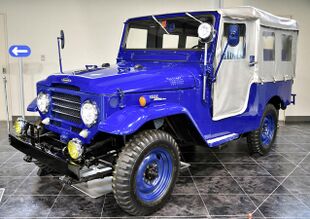 | |
| Overview | |
| Also called | Toyota Bandeirante (Brazil) |
| Production |
|
| Assembly |
|
| Body and chassis | |
| Body style |
|
| Layout | Front-engine, four-wheel-drive |
| Powertrain | |
| Engine |
|
| Dimensions | |
| Wheelbase |
|
History
- 1957 – A 4-door Station Wagon was added called the FJ35V which was based on a 2,650 mm (104.3 in) wheelbase. The Land Cruiser first imported into Australia by B&D Motors as the FJ25/28 cab chassis with Australian made bodies.[23] The Land Cruiser was the first Japanese vehicle to be regularly exported to the country.[24] A small number of Land Cruisers were initially used in the Snowy Mountains Scheme by contractor Theiss Constructions.[25]
- 1958 – FJ25 production commenced in Brazil ; this being the first Toyota vehicle built outside Japan. These were sold as the "Toyota Bandeirante" from January 1962 when the Toyota petrol engine was replaced with a Mercedes-Benz diesel engine. The word "bandeirante" means "flag carrier" in Portuguese. The FJ25 models were built until August 1968 in Brazil.[26] Production numbers were fairly low; in 1965, the production total was 961 vehicles.[27]
Bandeirante timeline
- 1959:
- FJ25 – Short open (topless) bushdrive car – Toyota F engine (May 1959 to 1960/61) – new in 1959 (also referred to as FJ251)
- 1960/1961:
- FJ25L – Short soft top bushdrive car – Toyota F engine (1960/1961 to 1960/1961) – new in 1960/1961 (also referred to as FJ251L)
- FJ151L – Short soft top bushdrive car – Toyota 2F engine (1960/1961 to December 1961) – replaces the FJ25/FJ251 and the FJ25L/FJ251L (there are few mentions in literature and no preserved ones known; it could be even doubted if it's ever been actually built)
- 1962:
- TB25L – Short soft top bushdrive car – Mercedes-Benz OM-324 engine (January 1962 to – 1966?) – replaces the FJ151L (or FJ25L/FJ251L?)
- TB25L – Short hard top bushdrive car – Mercedes-Benz OM-324 engine (January 1962 to – 1966?) – new in 1962
- TB41L – Long hard top bushdrive car – Mercedes-Benz OM-324 engine (September 1962 to July 1968) – new in 1962
- TB51L – Short pickup with native bed – Mercedes-Benz OM-324 engine (September 1962 to January 1966)
- 1965:
- TB51L3 – Short 3-door double cabin pickup with native bed and steel bed cover – Mercedes-Benz OM-324 engine (1965 to ?) – new in 1965; possibly only one unit was built
- 1962–1968:
- OJ32L – Short soft top bushdrive car – Mercedes-Benz OM-324 engine (1966? – to August 1968) – replaces the soft top TB25L
- OJ31L – Short hard top bushdrive car – Mercedes-Benz OM-324 engine (1966? – to August 1968) – replaces the hard top TB25L
- TB81L – Short pickup with native bed – Mercedes-Benz OM-324 engine (February 1966 to August 1968) – replaces the TB51L
J40 (1960)
| J40 | |
|---|---|
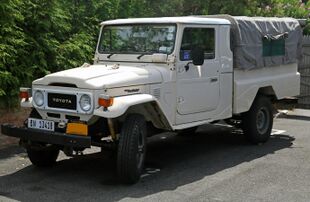 | |
| Overview | |
| Also called |
|
| Production |
|
| Assembly |
|
| Body and chassis | |
| Body style |
|
| Layout | Front-engine, four-wheel-drive |
| Powertrain | |
| Engine | |
| Transmission |
|
| Dimensions | |
| Wheelbase |
|
| Length | 3,840.5 mm (151.2 in) |
| Width | 1,666.2 mm (65.6 in) |
| Height |
|
| |uk|Kerb|Curb}} weight |
|
History
- 1960 – The 20 Series was upgraded to the now classic 40 Series. Toyota made many production changes by buying new steel presses. Mechanically, the FJ40 was given a new 93 kW (126 PS; 125 hp), 3.9 L F engine and the Land Cruiser finally received low-range gearing, but continued the three-speed main gearbox.
- 1965 – Global production surpassed 50,000 vehicles. The Land Cruiser was the best selling Toyota vehicle in the United States.
- 1968 – The 100,000th Land Cruiser was sold worldwide. Brazilian J40 production, as the Bandeirante, commenced in September. The Bandeirante has a Mercedes-Benz-built diesel engine generating a power output of 58 kW (79 PS; 78 hp).
- 1972 – The 200,000th Land Cruiser was sold.
- 1973 – The 300,000th Land Cruiser was sold. The first diesel Land Cruiser was introduced for export based on a long wheelbase with a six-cylinder H engine.
- 1974 – A four-cylinder 3.0 L B diesel engine was offered. The introduction of this engine boosted sales in Japan by putting the Land Cruiser in a lower tax compact freight-car category as compared to the 3.9 L petrol version.
Note: the new B diesel engine was different from the B petrol engine used in the original BJ.
- 1975 – The 3.9 L petrol engine was replaced by a larger, more powerful 4.2 L 2F unit and the FJ55 received front disc brakes. The 3.6 L H diesel engine was optional in some markets in the HJ45.[29]
- 1976 – FJ40 Land Cruiser (United States-version) received front disc brakes like the FJ55. The Toyota Land Cruiser Association was founded in California .
- 1977 – The Irish Army took delivery of the first of 77 FJ45 Land Cruisers. Although fast, reliable and with good off-road performance the vehicle tended to rust excessively in the wet Irish climate. A few which did not succumb to the effects of weather were repainted in gloss olive green and survive as ceremonial gun tractors at military funerals.
- 1978 – The first BJ/FJ40 and FJ55 models were officially sold in West Germany with both diesel (BJ40) and petrol engines (FJ40/55).
- 1979 – FJ40 (United States-version) was updated this year with a new wider, square bezel surrounding the headlights. Power steering and cooler were offered in FJ40 for the first time The diesel engine was improved, evolving into the 3.2 L 2B unit but only in Japanese markets.
- 1980 – The H diesel engine (HJ45) was replaced by the 4.0 L 2H engine (now with chassis code HJ47).[29]
- 1981 – the Diesel version received front disc brakes and the more powerful 3.4 L 3B engine, and the LWB BJ45 with 3B engine was added to the range.
- 1983 – the last FJ40s imported to the U.S. were 1983 models (mid-1982 to mid-1983). It is unknown how many were imported by Toyota, but many guess the number to be around 300. The 1983 FJ40s typically bring a premium for their rarity, though they are not much different from 1982 models (mid-1981 to mid-1982).
- 1984 – the North American market was limited to Canada with the BJ42, which had a 5-speed (overdrive) transmission that was widely sought. The original cost was around CA$14,000.
Gallery
J70 (1984)
| J70 | |
|---|---|
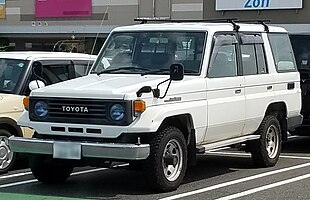 | |
| Overview | |
| Also called |
|
| Production | 1984–present |
| Assembly | |
| Body and chassis | |
| Body style |
|
| Layout | Front-engine, four-wheel-drive |
| Powertrain | |
| Engine | |
| Transmission |
|
| Dimensions | |
| Wheelbase |
|
| Length |
|
| Width |
|
| Height | |
History
- 1984 – J70 was introduced as a soft-top, hard-top, Fibre-reinforced plastic top, utility, cab-chassis, and Troop Carrier (inward facing rear seats). The petrol engine was replaced with a 4.0 L 3F engine. The 70 Light had a four-wheel coil spring solid-axle suspension for better ride quality. This lighter duty version of the Land Cruiser had the 22R 2.4 L four-stroke petrol engine, which actually were the 2L and 2L-T (turbocharged) 2.4 L diesel engines commonly found in the Toyota Hilux. The 70 Light was sold in some markets as the Bundera or the Landcruiser II, later called 70 Prado. The 70 Prado eventually became popular and evolved into the Toyota Land Cruiser Prado (J90). An automatic transmission (A440F) was introduced making it the first four-wheel drive Japanese vehicle with an automatic transmission.
- 1990 – New-generation of diesel engines were introduced for the Land Cruiser including a 3.4 L five-cylinder SOHC naturally aspirated engine (1PZ), and a 4.2 L six-cylinder SOHC naturally aspirated engine (designated the 1 HZ).
- 1993 to 1996 – the KZ 3.0 L turbocharged diesel engine replaced the LJ in the 70 series in European markets where this model was known as the KZJ70.
- 1993 – An advanced 24-valve, 4.5 L six-cylinder petrol engine, 1FZ-FE was introduced.
- 1999 – Toyota updated the 70 series in several ways. The solid front axle received coil-spring suspension. The rear leaf springs were lengthened for increased ride comfort and wheel travel. The six-bolt wheels were replaced with five-bolt wheels. Several smaller modifications to the drivetrain provided increased durability. The long-wheel-base models received new designations: 78 for the troop carrier, and 79 for the pickup.
- 2002 — HDJ79 was introduced to Australia with the 1HD-FTE 4.2 L six-cylinder 24-valve turbodiesel EFI engine.
- 2007 – Toyota's first turbodiesel V8 engine, the 1VD-FTV was introduced in some countries for the 70 Series Land Cruiser. Other modifications include the addition of a 4-door medium-wheel-base model (the 76) and an updated front-end on all models.
- 2012 – the 79 Double Cab pickup was introduced in the South African markets (with the 4.2 L diesel or 4.0 L petrol engines) and in the Australian market (with 4.5 L V8 Diesel engine).
- 2014 to 2015 – the 30th Anniversary Series 70 sold in Japan as a 4-door wagon or 4-door pickup with the 1GR-FE V6 petrol engine and 5-speed manual transmission.[37]
The Sixth and Seventh generations of the Land Cruiser are still being produced and sold in African and Latin American regions. Production of the Land Cruiser in Venezuela ended in 2008.
The 70 series is also still marketed in Australia as 4-door wagon, 2-door 'Troop Carrier', 2-door cab-chassis and 4-door cab-chassis.
The 70 series is also still being marketed in the Middle East as a 2-door and 4-door version as an SUV, and a 2-door and 4-door version as a pickup, and it is very popular there along with the regular Land Cruiser.
Gallery
Station Wagon series
J50 (1967)
| J50 | |
|---|---|
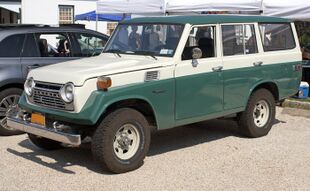 1979 FJ55 (US) | |
| Overview | |
| Production | 1967–1980 |
| Assembly | Toyota City, Japan (ARACO) |
| Body and chassis | |
| Body style | 5-door SUV |
| Layout | Front-engine, four-wheel-drive |
| Powertrain | |
| Engine | |
| Transmission |
|
| Dimensions | |
| Wheelbase | 2,700 mm (106.3 in) |
| Length | 4,675 mm (184.1 in) |
| Width | 1,735 mm (68.3 in) |
| Height | 1,865 mm (73.4 in) |
The Land Cruiser 55 was produced from 1967 to 1980. Toyota refers to the FJ55G and FJ55V as the first "real" station wagon in the Land Cruiser series, thus marking the beginning of the station wagon bodystyle. It was the first Land Cruiser to have fully enclosed box frame members. Of all the Land Cruiser wagons sold in the U.S., including the FJ45, it is the only one to not have hatch and tailgate in the rear, but rather a tailgate only with an electrically operated window that can be retracted into the tailgate.[38]
History
- 1967 – Production of the FJ55 began. The FJ55 was a 4-door station wagon version based on the FJ40's Drive-train, replacing the 4-Door FJ45V (I). It was colloquially known as the "Moose". It has also been referred to as a "pig" or an "iron pig". The FJ55 had a longer wheelbase (at 2,700 mm (106 in)) and was mainly designed to be sold in North America and Australia. Fire engine versions were also available, using the regular front clip but with open bodywork and no doors.[39]
- 1975 – January 1975 saw the F series engine being replaced by the 2F engine.[29] Unusual for Toyota, the model designation (e.g. FJ55) did not change, except in Japan, where it was changed to FJ56.
- July 1980 – Production ends.
Gallery
J60 (1980)
| J60 | |
|---|---|
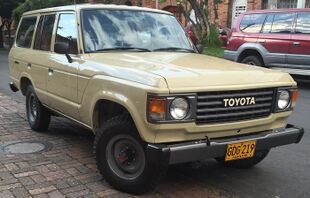 | |
| Overview | |
| Also called | Toyota Samurai (Venezuela) |
| Production | 1980–1992 |
| Assembly |
|
| Body and chassis | |
| Body style | 5-door SUV |
| Layout | Front-engine, four-wheel-drive |
| Powertrain | |
| Engine | |
| Transmission | |
| Dimensions | |
| Wheelbase | 2,730 mm (107.5 in) |
| Length | 4,675 mm (184.1 in) |
| Width | 1,800 mm (70.9 in) |
| Height | 1,750 mm (68.9 in) |
The Land Cruiser 60 series was produced from 1980 through 1990, for most markets but the Cumana Plant in Venezuela continued production until 1992 for their local market. It is a front engine, four-door wagon which can seat five to eight[40][41][42] people. The 60 series was available in the following exterior colours: Alpine White, Brown, Desert Beige, Freeborn Red, Royal Blue; and in the following metallic exterior colours: Charcoal Gray, Cognac, Gray-Blue, Rootbeer, Sky Blue, Stardust Silver.
History
- 1980 — The 60 series was introduced. While still retaining the rugged off-road characteristics of previous Land Cruisers, the 60 was designed to better compete in the emerging sport utility vehicle market. The 60 was given a variety of creature comforts like air conditioning, a rear heater and an upgraded interior. The FJ60's "2F" petrol engine was left unchanged from the "40" series while the six-cylinder 4.0 L 2H and the four-cylinder 3.4 L 3B diesel engines were added to the lineage. Less equipped versions were also available in many markets. In Europe this model was sold as the Land Cruiser Wagon Van.[43]
- 1981 – Land Cruiser sales surpassed 1 million and a high-roof version was introduced. The 60 series was introduced to South Africa when a stock Land Cruiser competed in the Toyota 1000 km Desert Race in the punishing wilds of Botswana.
- 1984 – This was the final year for the 40 series.
- 1984 – Alongside the 60 series, the 70 series was introduced.
- 1985 – The Direct-injection 12H-T turbodiesel engine was introduced.
- 1988 – The petrol engine was upgraded in some countries to a 4.0 L 3F-E EFI engine or to a 4.0 L 3F carburated engine. The FJ62G VX-Series was introduced allowing the Land Cruiser to be sold in Japan as a passenger vehicle.
- 1992 – Last FJ62 with a 4.0 L 3F carburated engine was built in Venezuela which was the only country producing the vehicles after production ended in Japan in 1990.
Gallery
J80 (1990)
| J80 | |
|---|---|
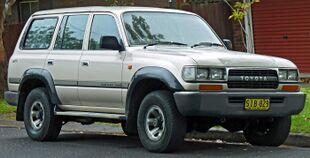 | |
| Overview | |
| Also called | |
| Production | |
| Assembly |
|
| Designer | Kitano Kizo (1987)[48][49][50] |
| Body and chassis | |
| Body style | 5-door SUV |
| Layout | Front-engine, four-wheel-drive |
| Powertrain | |
| Engine |
|
| Transmission | |
| Dimensions | |
| Wheelbase | 2,850 mm (112.2 in) |
| Length |
|
| Width |
|
| Height |
|
| |uk|Kerb|Curb}} weight |
|
The Land Cruiser 80 series was unveiled in October 1989 at the Tokyo Motor Show and launched in early 1990. It had swing-out back doors, which were replaced by a tailgate and hatch in 1994. The Land Cruiser was nicknamed the Burbuja (Bubble) in Colombia and Venezuela due to its roundness. The J80 was initially offered in two versions in these countries: the fully loaded VX and an entry level model that included a vinyl interior with optional air conditioning. In 1996, the entry model was upgraded to a medium equipped model named Autana, including cloth upholstery, standard air conditioning and power driver seat. The name is a reference to the Tepui mesa Autana, a spectacular plateau and cave system along the Guiana Shield craton. Land Cruiser sales reached 2 million vehicles.
History
- 1990 – The 80 series station wagon was introduced, replacing the 60 series. All 80s sold in North America and Europe now have a full-time four-wheel drive system. In Japan, Africa, and Australia, a part-time system was still available. 80s produced between 1990 and 1991 had an open centre differential which was lockable in 4HI and automatically locked in 4LO. From 1992 onward, vehicles with anti-lock brakes had a viscous coupling that sent a maximum of 30% torque to the non-slipping axle. The differential was lockable in 4HI and automatically locked in 4LO.
- 1990 – A new generation of diesel engines were introduced, adding to the engines available in the 80 series. The 80 series came with either a (3F-E) six-cylinder naturally aspirated petrol engine, a six-cylinder SOHC naturally aspirated diesel engine, (1HZ), or a 1HD-T direct injection turbo diesel.
- 1991 – By mid-1991 the 3F-E engine was introduced to the Australian market, a fuel injected version of the 3F engine.
- 1993 – An advanced 24-valve, 4.5 L six-cylinder petrol engine, 1FZ-FE was introduced. Larger brakes were added from October 1992 and the total wheelbase was made slightly longer. Front and rear axle lockers (code k294) were available as an option. The High Pinion Electric Locking front differential became available in the US models. In May 1993, Toyota began using R134 refrigerant in the air conditioning system. Serial numbers lower than JT3DJ81xxxxx38947 use the R12 refrigerant.
- 1994 – A limited edition called the Land Cruiser Blue Marlin (FZJ80) was introduced to the Australian market. They have 4.5 L straight 6 petrol engines with double-overhead cams, an automatic or manual transmission and 158 kW (215 PS; 212 hp) at 4,600 rpm. The car is blue from the Blue Marlin fish and they have the Blue Marlin logo throughout the car. Some of the features that the Blue Marlin included were altimeters, power windows, disc brakes, leather gear knob and steering wheel, central locking, leather trim, chrome handles and sidesteps, 16-inch alloy wheels, limited-slip differential, anti-lock brakes (ABS), power steering, CD or cassette players, fender flares, and a limited edition bull bar. Only 500 were made.
- 1995 – Driver and passenger airbags were introduced as were adjustable shoulder-belt anchors and an anti-lock braking system. The "T O Y O T A" badge was replaced with the modern, ovoid Toyota logo.
- 1996 – In the Dakar Rally, a pair of Land Cruisers finished first and second in the unmodified production class. North American and British models adopted anti-lock brakes and airbags as standard equipment. The Land Cruiser was withdrawn from Canada this year and was replaced by the more luxurious Lexus LX 450.
- 1997 – A limited run of Land Cruiser 80 was built specifically for collectors and is therefore called the Land Cruiser Collector's Edition. The Collector's Edition has Collectors Edition badging, "Collector's Edition" embroidered floor mats, automatic climate control, wheels with the "D" windows painted dark grey and special grey side moldings along with black pearl badging. The Collector's Edition was only available for the 1997 model year and the package was added to many of the available body colours.
- 1997 – A total of 4,744 FZJ80 Land Cruisers were sold in the United States as "40th Anniversary Limited Edition" models. They were available in 2 colours; Antique Sage Pearl (often referred to as Riverrock, Pewter, or Grey) and Emerald Green. The 40th Anniversary models included apron badges, a serial number badge on the centre console, black pearl exterior badges, "40th Anniversary Limited Edition" embroidered floor mats, automatic climate control, two-tone tan and brown leather interiors, and wheels with the "D" windows painted dark gray. Many were manufactured with the optional electric front and rear locking differentials, keyless entry, port-installed roof racks and running boards. There are some examples that did not have many of these optional extras. This was the last year for the electric locking front differentials.
- 2007 – Last 80-Series models was built in Venezuela[51][47] which was the only country producing the vehicles after production ended in Japan in 1997.
Gallery
| Designation | Engine | Power | Torque | Availability |
|---|---|---|---|---|
| FJ80R/L | 3F-E 4.0 L petrol I6 | 112 kW (152 PS; 150 hp) at 4,000 rpm | 290 N⋅m (214 lb⋅ft) at 3,000 rpm | Australia, North America |
| FZJ80 | 1FZ-F 4.5 L petrol I6 | 140 kW (190 PS; 188 hp) at 4,400 rpm | 363 N⋅m (268 lb⋅ft) at 3,200 rpm | Venezuela, Colombia, Bolivia (1994–1998) |
| FZJ80R/L | 1FZ-FE 4.5 L petrol I6 | 158 kW (215 PS; 212 hp) at 4,600 rpm | 373 N⋅m (275 lb⋅ft) at 3,200 rpm | Australia, Gulf Cooperation Council states, North Africa, North America until 1997 and Venezuela, Colombia, Bolivia (1998–2007) |
| HDJ80R | 1HD-T 4.2 L turbodiesel I6 | 115 kW (156 PS; 154 hp) at 3,600 rpm | 357 N⋅m (263 lb⋅ft) at 1,800 rpm | Australia, Japan |
| HZJ80R | 1HZ 4.2 L diesel I6 | 96 kW (131 PS; 129 hp) at 4,000 rpm | 271 N⋅m (200 lb⋅ft) at 2,000 rpm | Australia, Japan |
R means Right-hand drive version, excluding Japanese domestic market.
J100 (1998)
| J100 | |
|---|---|
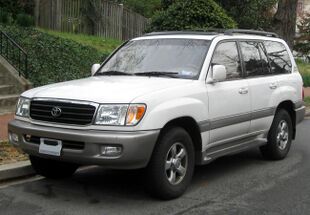 Toyota Land Cruiser (J100) Pre-facelift | |
| Overview | |
| Also called | Lexus LX 470 |
| Production | January 1998 – August 2007 |
| Model years | 1998–2007 |
| Assembly |
|
| Designer | Takeo Kondo |
| Body and chassis | |
| Body style | 5-door SUV |
| Layout | Front-engine, four-wheel-drive |
| Powertrain | |
| Engine |
|
| Transmission | |
| Dimensions | |
| Wheelbase | 2,850 mm (112.2 in) |
| Length | 4,890 mm (192.5 in) |
| Width | 1,941 mm (76.4 in) |
| Height | 1,849 mm (72.8 in) |
| |uk|Kerb|Curb}} weight | 2,320 kg (5,115 lb) |
In January 1998, the 100 series Land Cruiser was introduced to replace the 8-year-old 80 series. The 100 series was previewed in October 1997 as the "Grand Cruiser" at the 32nd Tokyo Motor Show. Development began in 1991 under code name 404T, with the final design being frozen in mid-1994.[52][53]
There are two distinct versions of the 100-series, the 100 and the 105. The two versions look very similar, but there are significant differences under the bodywork. Despite these differences and official model names, both the 100 and 105 are collectively known as the 100 series.
The 105 carried over the majority of its chassis and powertrain from the 80-series with coil suspended solid axles front and rear, and straight-6 petrol and diesel engines. These models were only sold in African, Australian, Russian, and South American markets.
In 1998, a suspension system combining Active Height Control (AHC) and Skyhook TEMS Toyota Electronic Modulated Suspension on the Land Cruiser J100 was introduced.[54]
In 2002, Toyota introduced Night View, the first worldwide series production active automotive night vision system, on the Toyota Land Cruiser Cygnus or Lexus LX470. This system uses the headlight projectors emitting near infrared light aimed like the car's highbeam headlights and a CCD camera then captures that reflected radiation, this signal is then processed by a computer which produces a black-and-white image which is projected on the lower section of the windshield.[55] It was also the first Toyota vehicle with roll-over sensor and control logic.[56]
The 100 models were fitted with a slightly wider chassis,[57] independent front suspension (IFS) and two new engines. The change to IFS was a first for a Land Cruiser, and was made (in combination with rack-and-pinion steering) to improve on-road handling. However it also limited the vehicle's off-road capability and durability, hence the decision to offer the solid axle 105 models alongside the IFS 100 models in some markets was made. The table below identifies the range of 100 and 105 models and their worldwide availability.
Despite the 100 and 105 bodies being very similar, there are some exterior visual indications between both models. The most obvious is the front end of the vehicle often appearing lower than the rear on the 100 models, due to the IFS. The other indicator is the design of the wheels. The 100 models have almost flat wheel designs, while the 105 models have dished wheels. This difference allows both versions to retain similar wheel tracks, despite the 100 having a relatively wider axle track to allow for the IFS system.
The introduction of a V8 engine was also a first for a Land Cruiser, and was specifically intended to improve sales in the North-American market, where it was the only engine available. In Australia, the 100 V8 was initially only available in the range-topping GXV model, while entry and mid-range models were the 105 powered by the 1FZ-FE I6 petrol, or 1HZ diesel engines. The new 1HD-FTE turbo-diesel 100 was added to the Australian range in October 2000 after being available in Europe and the UK since the vehicle's launch in 1998. The automotive press in Australia were critical of Toyota's decision to offer the acclaimed 1HD-FTE engine only in combination with IFS. Australian 4WD Monthly magazine stated "We will never forgive Toyota for going independent at the front with the mighty 4.2 turbo-diesel".
The 100 series formed the basis for the Lexus LX 470, which was also sold in Japan as the Toyota Cygnus.
The 100 series was called the Toyota Land Cruiser Amazon in the UK and Ireland from 1998 to 2007.
In 2000, Toyota celebrated the 50th anniversary of the Land Cruiser with commemorative models offered in several countries. Total global production to date was 3.72 million vehicles.
The 100 series remained in production until late 2007, with several minor facelifts such as headlights, taillights, front grille, rear spoiler and specification changes introduced over the years.
| Designation | Engine | Power | Torque | Availability |
|---|---|---|---|---|
| HZJ105 | 1HZ 4.2 L diesel I6 | 96 kW (131 PS; 129 hp) at 3,800 rpm | 271 N⋅m (200 lb⋅ft) at 2,200 rpm | Africa, Asia, Australia, Middle East, South America |
| FZJ105 | 1FZ-FE 4.5 L petrol I6 | 180 kW (245 PS; 241 hp) at 4,600 rpm | 410 N⋅m (302 lb⋅ft) at 3,600 rpm | Africa, Asia, Australia, Middle East, South America |
| FZJ100 | 1FZ-FE 4.5 L petrol I6 | 180 kW (245 PS; 241 hp) at 4,600 rpm | 410 N⋅m (302 lb⋅ft) at 3,600 rpm | Middle East, China |
| UZJ100 | 2UZ-FE 4.7 L petrol V8 | 170 kW (231 PS; 228 hp) at 4,800 rpm | 410 N⋅m (302 lb⋅ft) at 3,400 rpm | Africa, Asia, Australia, China, Europe, Japan, Middle East, North America, UK |
| HDJ1001 | 1HD-T 4.2 L turbodiesel I6 | 123 kW (167 PS; 165 hp) at 3,600 rpm | 352 N⋅m (260 lb⋅ft) at 2,000 rpm | Africa, South America |
| HDJ1002 | 1HD-FTE 4.2 L turbodiesel I6 | 150 kW (204 PS; 201 hp) at 3,400 rpm | 430 N⋅m (317 lb⋅ft) at 1,400 rpm | Australia*, Europe, Japan, Middle East, New Zealand, UK |
*This engine was not introduced in Australia until 2000.
The 100-series is generally considered a durable and reliable vehicle, however there have been three known issues identified, generally for vehicles operating in harsh conditions:
- The IFS 100-series gained a reputation for front suspension failures in operating conditions where the front suspension was prone to hitting the bump stops. Several companies produce strengthened lower wishbones to prevent cracks from developing.[58]
- Both the IFS 100 and Live-axle 105 models have been reported to be suffering from broken front differential centres when driven in harsh conditions.[59] The most common front differential failures in IFS models are reported in vehicles produced between mid-1997 and mid-1999 (i.e. the model years 1998 and 1999), when Toyota fitted the 100 Series IFS with a 2-pinion front differential (the pinion gear would flex away from the ring gear under shock loads). In 1999 (model year 2000) the IFS Landcruiser received a 4-pinion front differential that was more robust – fewer failures were reported.[60][61]
Gallery
J200 (2007)
| J200 | |
|---|---|
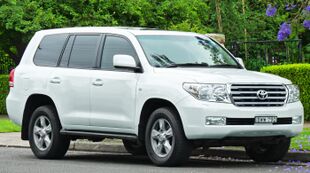 2011 Toyota Land Cruiser (UZJ200; pre-facelift) | |
| Overview | |
| Also called |
|
| Production | September 2007 – March 2021[62] |
| Model years | 2008–2021 (US) |
| Assembly | |
| Designer |
|
| Body and chassis | |
| Body style | 5-door SUV |
| Layout | Front-engine, four-wheel-drive |
| Platform | Toyota F1[66] |
| Related |
|
| Powertrain | |
| Engine |
|
| Power output |
|
| Transmission | |
| Dimensions | |
| Wheelbase | 2,850 mm (112.2 in) |
| Length | 4,990 mm (196.5 in) |
| Width | 1,980 mm (78.0 in) |
| Height | 1,945–1,970 mm (76.6–77.6 in) (adjustable) |
| |uk|Kerb|Curb}} weight | 2,405–2,740 kg (5,302–6,041 lb) |
| Chronology | |
| Successor | Toyota Land Cruiser (J250) (North America) |
In 2002, a 5-year development plan on a successor to the 100-series platform commenced under Sadayoshi Koyari and Tetsuya Tada. By 2004, 10 years after the design selection of its predecessor in 1994, a final production design was settled on for the 2008 J200. Prototype related tests were conducted for over 2 years between 2004 and early 2007. The redesigned Toyota Land Cruiser was introduced in late 2007. Known as the 200 Series, it shares the Lexus LX 570's platform and overall design. The frame was new, derived from the second-generation Tundra[citation needed] but shortened and strengthened by 20 percent. Bigger brake rotors and calipers were added and the front suspension was strengthened. The underbelly is also protected by skid plates. The roof pillars were redesigned to better protect occupants in a rollover.
The 200 Series encountered some criticism due to its bland body restyling, with some[who?] claiming that Toyota has 'overdeveloped' the classic trademarked Land Cruiser identity in its efforts to fit the Land Cruiser into modern 21st century motoring and vehicle design.
The vehicle entered production in September 2007 and was available for sale from September or November, depending on country. It became available in Venezuela for sale in early November of the same year under the local nickname of "Roraima" (taken from Mount Roraima).
The 200 Series, offered numerous features and upgrades over its predecessor not limited to the cosmetic changes made to the body and interior, including:
- Smart Entry — A sensor is triggered when the remote is brought near the vehicle, allowing the user to simply touch the door handle to open it.
- Smart Start — Start/Stop push button for ignition; a key is not required.
- 4-zone climate control on Sahara models, with outlet vents increased from 18 to 28
- 10 airbags (VX & Sahara)
- A stronger and lighter frame
Various driver assist technologies not offered on previous models are included as standard, including:
- CRAWL, a four-wheel drive control system that operates like an off-road cruise control, automatically maintaining a low uniform vehicle speed using brakes and throttle
- Downhill Assist Control
- Multi-terrain anti-lock braking system (ABS)
- Kinetic Dynamic Suspension System (KDSS), allows for greater wheel articulation
- An optional rear-view camera (VX)
- Leather seats are available in full option (VX)
Engine and transmission improvements include:
- An all new optional V8 diesel engine, the Toyota VD engine (a twin-turbocharged version of the engine used in the 70 Series since 2007).
- Automatic transmission included as standard across all levels of trim of the 200 Series, a five-speed manual transmission is offered only with the 4.0 L GX models (in selected regions). A five-speed automatic gearbox is assigned to the 4.7 L petrol models, while the 4.5 L diesel models receive a six-speed automatic.
In Japan, the Land Cruiser had an update in 2009 when it received the 4.6 L V8 1UR-FE engine and the gearbox was replaced with a 6-speed automatic.[70] Although the new 4608 cc 1UR-FE is smaller than the old 4663 cc 2UZ-FE engine, the power has been increased from 212 to 234 kW (288 to 318 PS; 284 to 314 hp), torque increased from 448 to 460 N⋅m (330 to 339 lb⋅ft) and fuel consumption improved from 6.6 to 7.1 km/L (19 to 20 mpg‑imp; 16 to 17 mpg‑US) (Japan 10·15 mode measurement).
In the Middle East, the Land Cruiser 200 series was introduced in late 2007 as a 2008 model, for 2008 to 2010 there was three engine choices:
- 179 kW (243 PS; 240 hp) 4.0 L 1GR-FE petrol engine
- 202 kW (275 PS; 271 hp) 2UZ-FE petrol engine
- 162–173 kW (220–235 PS; 217–232 hp) 1VD-FTV 4.5 L turbo diesel engine[71]
In Europe and Asia, the Euro4 diesel (2007-2010) model had 213 kW (286 hp).
Starting in 2011, the 270 kW (367 PS; 362 hp) 3UR-FE engine was offered along with the previous engines.[72] For 2012, the 1GR-FE gained dual VVT-i and power was increased to 202 kW (275 PS; 271 hp), the 4.7 L 2UZ-FE was dropped in favour of the new 227 kW (309 PS; 304 hp) 4.6 L 1UR-FE, and the 5.7 L and 4.5 L diesel were unchanged, although the latter was dropped in some markets.[73]
In North America, the Land Cruiser 200 series is offered with one trim level and engine, the 5.7 L 3UR-FE V8 petrol engine producing 284 kW (386 PS; 381 hp) and 544 N⋅m (401 lb⋅ft) of torque channeled through a six-speed automatic. Towing is rated at 3,700 kg (8,200 lb). Beige or black leather upholstery is standard along with a 14 speaker JBL sound system. The only wheel choice is 18 in (460 mm) allowing a lot of sidewall so the vehicle can be driven off-road without modification though a more aggressive tread pattern is advised for deep mud.
For the 2013 model year, Toyota added all previously optional safety and luxury options as standard. The Land Cruiser now gets pushbutton start, HID headlights with beam level adjustment, a power moonroof, automatic rain sensing windshield wipers, heated and ventilated (perforated leather) front and only heated rear seats, a rear-seat DVD entertainment system, bluetooth, rearview camera with parking sensors, navigation system, HD radio and Entune. Another new feature is the Multi-terrain Select system which helps control wheelspin and brake lockup giving the selectable choices of: Rock, Rock & Dirt, Mogul, Loose Rock, and Mud & Sand and with an addition to the Multi-terrain Select system a feature known as adaptive Anti-lock Braking system which adapts to the condition of the road like mud or sand and efficiently uses the ABS to reduce braking distance on any type of terrain.[74]
In Oceania, the 200 Series is offered in four different levels of trim: GX, GXL, VX and Sahara.
In August 2015, Toyota launched an updated, face-lifted version of the J200 Land Cruiser in Japan, which was later sold globally. This version first appeared in the United States in 2015 for the 2016 model year. The new version has several mechanical changes, including a new 8-speed electronically controlled automatic transmission (ECT-i) mated to the original 5.7 L 3UR-FE V8 petrol engine, larger front disc brakes, and a higher axle ratio (3.30:1 vs 3.90:1 in the previous years). Updates to the front fascia, grill, headlamps (with daylight running lamps), rear tail lamps and bumpers were the main exterior highlights of the facelift. Interior changes included a new multimedia system and interface with larger screens front and back, as well as refreshed interior styling.
In China, the Land Cruiser 200 was produced from 2008 to 2016 by Sichuan FAW Toyota Motor. The 4.0 L 1GR-FE V6 and 4.7 L 2UZ-FE V8 were the available engine choices – both paired to a 5-speed automatic gearbox. Trim levels were the 4.0 GX-R, 4.0 VX, 4.7 VX and 4.7 VX-R.[75]
In February 2019, Toyota introduced a Heritage edition of the Land Cruiser at the Chicago Auto Show as part of the 60th anniversary of the introduction of the FJ40. Toyota will only build 1200 vehicles and they will only be available as a 5-seater sold in the United States. Sales are expected to begin in the third quarter of 2019 for the 2020 model year.[76]
In December 2020, Toyota confirmed to Road & Track that the Land Cruiser would be discontinued in North America after 2021.[77]
Gallery
J300 (2021)
| J300 | |
|---|---|
 2021 Toyota Land Cruiser ZX (VJA300) | |
| Overview | |
| Production | March 2021 – present |
| Model years | 2022–present (Middle East) |
| Assembly | Japan: Toyota, Aichi (Yoshiwara plant) |
| Designer | |
| Body and chassis | |
| Body style | 5-door SUV |
| Layout | Front-engine, four-wheel-drive |
| Platform | TNGA: GA-F[81] |
| Related | |
| Powertrain | |
| Engine |
|
| Power output |
|
| Transmission |
|
| Dimensions | |
| Wheelbase | 2,850 mm (112.2 in) |
| Length | 4,950–5,015 mm (194.9–197.4 in)[84] |
| Width | 1,980–1,990 mm (78.0–78.3 in) |
| Height | 1,945 mm (76.6 in) |
| |uk|Kerb|Curb}} weight | 2,310–2,645 kg (5,093–5,831 lb) |
The J300 series Land Cruiser was unveiled on 9 June 2021.[81] Its development was led by Toyota chief engineer Takami Yokoo.[85] Built on the body-on-frame GA-F platform, the frame itself was redesigned to reduce weight and increase rigidity. The total weight of the vehicle was reduced by 200 kg (441 lb) compared to its predecessor. Other improvements claimed include lowered center of gravity, weight distribution, and an improved suspension structure.
Exterior dimensions including the total length, total width, and wheelbase, as well as both the departure and approach angles have been kept largely same as the previous model to retain its off-road performance. It carries over the approach angle of 32 degrees from its predecessor. The departure angle can reach up to 26.5 degrees depending on the version, while ground clearance measures 230 mm (9.1 in). Toyota has equipped the vehicle with an adaptive variable suspension (AVS), an upgraded Electronic Kinetic Dynamic Suspension System (E-KDSS), a more advanced Multi-Terrain Select system with Deep Snow and Auto modes, and a Multi-Terrain Monitor system which incorporates an underbody camera.[86]
For this generation, Toyota ceased to offer V8 engine options in favour of a 3.4-litre V35A-FTS twin-turbocharged V6 petrol engine producing 305 kW (409 hp; 415 PS), and a 3.3-litre F33A-FTV twin-turbocharged V6 diesel engine producing 227 kW (304 hp; 309 PS).[87] A 4.0-litre naturally-aspirated V6 engine is carried over from the previous model.[88]
A GR Sport/GR-S variant is also available for the first time. It is 5 mm (0.2 in) shorter than the standard model, and uses more body adhesive to enhance structural rigidity. The GR Sport model also offers front and rear differential locking, as opposed to only centre locking in the standard 300 Series.[89][90]
It went on sale in the United Arab Emirates and Kuwait on 20 June 2021, in Japan on 2 August 2021, in Australia on 5 October 2021, and in Indonesia on 13 January 2022.[91] The Japanese model is available in four 7-seat petrol grades: AX, VX, GR Sport and ZX, one 5-seat petrol grade: GX and two 5-seat diesel grades: GR Sport and ZX.[87][92][93] The Australian model is available in six grades: GX, GXL, VX, Sahara, GR Sport and Sahara ZX.[94][95][96] The Indonesian model is available in two grades: VX-R and GR-S.
The J300 series Land Cruiser is not sold in the United States and Canada due to slow sales for its J200 series predecessor, as well as limited production capacity; the related Lexus LX remains available.[97][98] In those markets the J200 series is replaced by the slightly smaller J250 series in 2024.[99]
Land Cruiser Se Concept (2023)
The Land Cruiser Se is a monocoque-based three-row battery electric concept SUV using the Land Cruiser nameplate showcased at the 2023 Japan Mobility Show.[100]
Sales
| Year | Japan[101] | Australia | United States | Saudi Arabia |
|---|---|---|---|---|
| 1999 | ||||
| 2000 | 15,509[102] | |||
| 2001 | 7,591[102] | |||
| 2002 | 6,752[103] | |||
| 2003 | 6,671[103] | |||
| 2004 | 4,996 | 6,778[104] | ||
| 2005 | 5,895 | 4,870[104] | ||
| 2006 | 4,431 | 3,376[105] | ||
| 2007 | 4,946 | 3,251[105] | ||
| 2008 | 8,094 | 3,898[106] | ||
| 2009 | 2,772 | 2,261[107] | ||
| 2010 | 2,908 | 1,807[107] | ||
| 2011 | 3,146 | 1,662[108] | ||
| 2012 | 4,109 | 2,895[109] | ||
| 2013 | 3,990 | 3,082[110] | ||
| 2014 | 3,800 | 3,158[110] | ||
| 2015 | 3,360 | 9,202[111] | 2,687[112] | |
| 2016 | 6,020 | 11,813[113] | 3,705[114] | |
| 2017 | 4,250 | 12,814[115] | 3,100[116] | |
| 2018 | 3,610 | 13,677[117] | 3,222[118] | |
| 2019 | 2,650 | 13,802[119] | 3,536[118] | |
| 2020 | 1,960 | 15,078[120] | 3,147[121] | 7,430[122] |
| 2021 | 1,530 | 14,356[123] | 3,711[124] | |
| 2022 | 35,390[125] |
Use by militant groups and military forces
Owing to its durability and reliability, the Land Cruiser, along with the smaller Toyota Hilux, has become popular among militant groups in war-torn regions.[126] U.S. counter-terror officials enquired of Toyota how the extremist group Islamic State had apparently acquired large numbers of Toyota Land Cruisers and Hiluxes. Mark Wallace, the CEO of the Counter Extremism Project said, "Regrettably, the Toyota Land Cruiser and Hilux have effectively become almost part of the ISIS brand."[127]
References
- ↑ "All-New LandCruiser 300 | 7 Seat 4WD Large SUV". Australia: Toyota. https://www.toyota.com.au/landcruiser-300.
- ↑ "Vehicle Heritage – Land Cruiser". Toyota. http://www.toyota-global.com/showroom/vehicle_heritage/landcruiser/.
- ↑ 3.0 3.1 "Toyota just sold its 10 millionth Land Cruiser". https://www.autoblog.com/2019/09/20/toyota-10-millionth-land-cruiser/.
- ↑ "Model BJ – Built From Good Materials – 1951–1955". Toyota Land Cruiser Data Library. Toyota. http://www.toyota.com.kw/english/toyota_models___/landcruiser/history/html/history/models/model_bj.html.
- ↑ "Worldwide Annual Production". Toyota Land Cruiser Data Library. Toyota. http://www.toyota.com.kw/english/toyota_models___/landcruiser/history/html/sales/production_annual.html.
- ↑ "Autoweb Australia". Autoweb.com.au. http://www.autoweb.com.au/cms/A_51038/title_Toyota-Landcruiser-Celebrates-Snowy-Mountains-Anniversary/newsarticle.html.
- ↑ "SPY PHOTOS: More New Toyota LandCruiser". Worldcarfans.com. 13 February 2007. http://www.worldcarfans.com/10702135056/spy-photos-more-new-toyota-landcruiser.
- ↑ GoAutoMedia (5 April 2008). "Lexus LX LX570 5-dr wagon – First drive: LX570 is the lap of Lexus SUV luxury". GoAuto. http://www.goauto.com.au/mellor/mellor.nsf/story2/6A92D5E6237743F3CA25741E0004C020.
- ↑ "Toyota 200 Series LandCruiser". Drive.com.au. 11 January 2008. http://news.drive.com.au/drive/new-car-reviews/toyota-200-series-landcruiser-20080111-14stj.html.
- ↑ "Toyota Land Cruiser is Discontinued". US: Toyota. 2021. https://www.toyota.com/landcruiser/.
- ↑ McAleer, Brendan (June 10, 2021). "Toyota upgrades near-legendary Land Cruiser – but good luck getting your hands on one". The Globe and Mail. Canada. https://www.theglobeandmail.com/drive/article-toyota-upgrades-near-legendary-land-cruiser-but-good-luck-getting-your/.
- ↑ Chan, Mick (2019-09-23). "Toyota Land Cruiser surpasses 10 million unit mark". Malaysia: Driven Communications. https://paultan.org/2019/09/23/toyota-land-cruiser-surpasses-10-million-unit-mark/.
- ↑ "Toyota AK10: The Grandfather of All Land Cruisers". 19 January 2011. https://offroadaction.ca/2011/01/19/toyota-ak10-the-grandfather-of-all-land-cruisers/.
- ↑ "Section 5. Wartime Research and Production: Item 8. Prototype Production of a Range of Vehicles". 75-Year History. Toyota Motor Corporation. https://www.toyota-global.com/company/history_of_toyota/75years/text/taking_on_the_automotive_business/chapter2/section5/item8_b.html.
- ↑ 15.0 15.1 Clifford, Joe (2018-01-25). "Toyota Land Cruiser history: Heavy and Light Duty edition" (in en-GB). https://mag.toyota.co.uk/history-of-the-toyota-land-cruiser-heavy-and-light-duty-models-2/.
- ↑ "Land Cruiser Special Website, History: Evolution" (in en). Toyota Motor Corporation. https://global.toyota/en/mobility/toyota-brand/features/landcruiser/history/evolution/lineage.html.
- ↑ Clifford, Joe (2013-09-03). "Toyota Land Cruiser History" (in en-GB). https://mag.toyota.co.uk/history-of-the-toyota-land-cruiser-station-wagon-models/.
- ↑ Weiss, C.C. (2023-08-03). "Toyota Land Cruiser rises from the grave as cheaper, true-to-roots 4x4" (in en-US). https://newatlas.com/automotive/toyota-land-cruiser-250-series/.
- ↑ "10 things you might not know about the Toyota Land Cruiser" (in en). 2021-08-13. https://www.topgear.com/car-news/list/10-things-you-might-not-know-about-toyota-land-cruiser.
- ↑ "World premiere of the all-new Toyota Land Cruiser (300 Series)" (in en). 2021-06-09. https://newsroom.toyota.eu/world-premiere-of-the-all-new-toyota-land-cruiser-300-series/.
- ↑ 21.0 21.1 21.2 The Story of Land Cruiser. Tokyo: 4×4 Magazine Co.. 1985. http://forum.ih8mud.com/fj25-owners-group/241941-toyota-historical-pictures-3.html. Retrieved 9 November 2009.
- ↑ Ruiz, Marco (1986). 'The Complete History of the Japanese Car: 1907 to the Present. Rome: ERVIN srl. p. 186. ISBN 0-517-61777-3.
- ↑ Davis, Pedr (1999). The Long Run – Toyota: The first 40 years in Australia. South Hurstville: Type Forty Pty Ltd. p. 24. ISBN 0-947079-99-8.
- ↑ "Land Cruisers from Japan". The Age: p. 1. 20 September 1957.
- ↑ O'Kane, Tony (18 January 2010). "2010 Toyota Landcruiser 76 Series GXL Wagon Road Test and Review". The Motor Report. http://www.themotorreport.com.au/48703/2010-toyota-landcruiser-76-series-gxl-wagon-road-test-and-review/.
- ↑ "Toyota's first production outside Japan at Toyota do Brasil". 75 years of Toyota: Expansion into Latin America. Toyota Motor Corporation. http://www.toyota-global.com/company/history_of_toyota/75years/text/taking_on_the_automotive_business/chapter2/section9/item3_a.html.
- ↑ "VW-Tochter: Erfolg mit Fusca" (in de). Der Stern (Rudolf Augstein) (39): 134. 19 September 1966. http://www.spiegel.de/spiegel/print/d-46414589.html. Retrieved 3 January 2015.
- ↑ Wijaya, Irsyaad (19 February 2018). "Cerita Karir Perdana Toyota Land Cruiser FJ40 di Indonesia" (in id). GridOto.com (Indonesia). https://otomania.gridoto.com/amp/read/241184256/cerita-karir-perdana-toyota-land-cruiser-fj40-di-indonesia?page=2.
- ↑ 29.0 29.1 29.2 29.3 29.4 29.5 29.6 29.7 29.8 Toyota Vehicle Identification Manual. Japan: Toyota Motor Corporation, Overseas Parts Department. 1984.
- ↑ 30.0 30.1 "Affiliates (Toyota wholly-owned subsidiaries)-Toyota Auto Body Co., Ltd.". Toyota Motor Corporation. 2012. http://www.toyota-global.com/company/history_of_toyota/75years/data/automotive_business/production/production/japan/general_status/toyota_auto_body.html.
- ↑ "Oficializado Ensamble de Toyota - Archivo Digital de Noticias de Colombia y el Mundo desde 1.990" (in Spanish). eltiempo (Columbia). 8 February 1991. https://www.eltiempo.com/archivo/documento/MAM-21709.
- ↑ ""Nada les pasa" (1992): Los Toyota Land Cruiser colombianos y su eterna robustez". 13 June 2021. https://www.elcarrocolombiano.com/clasicos/nada-les-pasa-1992-los-toyota-land-cruiser-colombianos-y-su-eterna-robustez/.
- ↑ Dias, Miguel (May 2021). "Toyota celebra 50 anos de produção nacional da fábrica de Ovar" (in Portuguese). Razao Automovel (Portugal). https://www.razaoautomovel.com/2021/05/toyota-celebra-50-anos-de-producao-nacional-da-fabrica-de-ovar.
- ↑ Mastrostefano, Raffaele, ed (1990) (in it). Quattroruote: Tutte le Auto del Mondo 1990. Milano: Editoriale Domus S.p.A. pp. 1340–1341.
- ↑ "Toyota Bundera Dimensions 1985 - Length, Width, Height, Turning Circle, Ground Clearance, Wheelbase & Size". Australia. https://www.carsguide.com.au/toyota/bundera/car-dimensions/1985.
- ↑ "LandCruiser 70 Specifications". https://www.toyota.com.au/-/media/toyota/main-site/vehicle-hubs/lc70/files/lc70_spec_data_jun2021.pdf.
- ↑ Kino, Ron (15 December 2014). "First Drive: Toyota Land Cruiser 70 Series". Motor Trend. http://www.motortrend.com/roadtests/suvs/1412_toyota_land_cruiser_70_30th_anniversary_edition_first_drive/.
- ↑ "Land Cruiser – Model 55 Series". Toyota Motor Corporation Global Website. http://www.toyota-global.com/showroom/vehicle_heritage/landcruiser/collection/model_55_1.html.
- ↑ (in ja) 自動車ガイドブック, 25, Japan: Japan Automobile Manufacturers Association, 10 October 1978, p. 276, 0053-780025-3400
- ↑ "Vehicle Specifications Toyota 56". New South Wales, Australia: Department of Motor Transport. 29 January 1985. https://roads-waterways.transport.nsw.gov.au/rvd-pre1999/data/pdf/11787.pdf.
- ↑ "Vehicle Specifications Toyota 28". New South Wales, Australia: Department of Motor Transport. 28 May 1984. https://roads-waterways.transport.nsw.gov.au/rvd-pre1999/data/pdf/11709.pdf.
- ↑ "Vehicle Specifications Toyota 11". New South Wales, Australia: Department of Motor Transport. January 2002. https://roads-waterways.transport.nsw.gov.au/rvd-pre1999/data/pdf/11665.pdf.
- ↑ Visart, Etienne, ed (7 February 1985). "Nieuw in 1985 (1)" (in nl-be). De AutoGids (Brussels, Belgium: Uitgeverij Auto-Magazine) 6 (140): 116.
- ↑ de Feijter, Tycho (2018-03-06). "Crazy Car Production Days of Guangdong: Guangdong Wanli". https://chinacarhistory.com/2018/03/06/crazy-car-production-days-of-guangdong-guangdong-wanli/.
- ↑ de Feijter, Tycho (2018-12-24). "Crazy Car Production Days of Guangdong: Hebei Xinkai Automobile". https://chinacarhistory.com/2018/12/24/crazy-car-production-days-of-guangdong-hebei-xinkai-automobile/.
- ↑ "General Status of Plants in Japan – Honsha Plant". Toyota. 2012. http://www.toyota-global.com/company/history_of_toyota/75years/data/automotive_business/production/production/japan/general_status/honsha.html.
- ↑ 47.0 47.1 "Toyota Land Cruiser Reviews: Research New & Used Models". Motor Trend. US. https://www.motortrend.com/cars/toyota/land-cruiser/.
- ↑ "メンテナンス情報 (Maintenance information) | J-PlatPat/AIPN". https://www.j-platpat.inpit.go.jp/c1800/DE/JP-0790318/49FECC73D527A316DFAC2AA6DF8B063B12A9EDC2C46309FE302981597D05714E/35/en.
- ↑ "メンテナンス情報 (Maintenance information) | J-PlatPat/AIPN". https://www.j-platpat.inpit.go.jp/c1800/DE/JP-0790318-002/49FECC73D527A316DFAC2AA6DF8B063B12A9EDC2C46309FE302981597D05714E/35/en.
- ↑ "メンテナンス情報 (Maintenance information) | J-PlatPat/AIPN". https://www.j-platpat.inpit.go.jp/c1800/DE/JP-0790318-001/49FECC73D527A316DFAC2AA6DF8B063B12A9EDC2C46309FE302981597D05714E/35/en.
- ↑ "History of the Toyota Land Cruiser (Station Wagon models)". UK: Toyota. 3 September 2013. http://blog.toyota.co.uk/history-of-the-toyota-land-cruiser-station-wagon-models.
- ↑ "New Land Cruiser gets V8 – Toyota Land Cruiser – includes related article on the Lexus LX450". Automotive Industries. 1998. http://findarticles.com/p/articles/mi_m3012/is_n2_v178/ai_20301572/.
- ↑ Johnson, Richard (25 July 1994). "Sport-utilities highlight future PLANS". Crain Communications Inc.. http://www.europe.autonews.com/article/19940725/ANA/407250701/sport-utilities-highlight-future-plans.[yes|permanent dead link|dead link}}]
- ↑ "75 Years of TOYOTA | Technical Development | Chassis". Toyota. 2012. http://www.toyota-global.com/company/history_of_toyota/75years/data/automotive_business/products_technology/technology_development/chassis/index.html.
- ↑ "Safety Presentation". Japan: Toyota. 2004. http://www.toyota.co.jp/en/safety_presen/tech/40.html.
- ↑ "Technical Development Electronics Parts". Toyota Motor Corporation. 2012. http://www.toyota-global.com/company/history_of_toyota/75years/data/automotive_business/products_technology/technology_development/electronics_parts/index.html.
- ↑ "What is the Difference: Land Cruiser 100 vs. 105". Modifind Off-Road. 2020. https://www.modifind.com/offroad/technical/what-is-the-difference-land-cruiser-100-vs-105/.
- ↑ Pepper, Robert (July 2006). "LC100 Suspension Solutions". Overlander 4WD Magazine. http://www.overlander.com.au/equipment/index/full/68/LC100-Suspension-Solutions.
- ↑ "2005 4×4 of the Year", Australian 4WD Monthly: 63–67, October 2005
- ↑ "Toyota Land Cruiser Petrol Diesel 1998-2007 Haynes Service Repair Workshop Manual - Landcruiser Workshop Repair Manual". https://www.landcruiserworkshopmanual.com.au/Item/toyota-land-cruiser-78-79-100-105-series-workshop-manual.
- ↑ "Toyota Land Cruiser 1998 - 2007". https://au.haynes.com/products/productID/203.
- ↑ Dowling, Joshua (23 November 2020). "Toyota LandCruiser 200 Series V8 diesel to end production March 2021". CarAdvice (Australia). https://www.caradvice.com.au/903108/toyota-landcruiser-200-series-v8-to-end-production-march-2021/.
- ↑ "Japanese Production Sites". Toyota. 6 March 2015. http://newsroom.toyota.co.jp/en/corporate/companyinformation/manufacturing.
- ↑ Ito, Takanori; Kuniaki Toyooka & Katsumi Nakashima et al., "Automobile and/or toy replica thereof", US patent D576919S, published 2008-09-16, assigned to Toyota Motor Co. Ltd.
- ↑ Matsuno, Keisuke & Kouji Katsuno, "Motor vehicle", US patent D761704, published 2016-07-19, assigned to Toyota Motor Co. Ltd.
- ↑ "トヨタ自動車「ランドクルーザー」". 30 November 2007. https://xtech.nikkei.com/dm/article/HONSHI/20071130/143401/.
- ↑ "Toyota Japan Land Cruiser". Toyota.jp. http://toyota.jp/landcruiser/dynamism/engin/index.html.
- ↑ "Goonet 2007 Land Cruiser". Goo-net.com. http://www.goo-net.com/catalog/TOYOTA/LAND_CRUISER/10043240/index.html.
- ↑ "Exterior Dimensions". http://pressroom.toyota.com/pr/tms/toyota/document/2008LandCruiser_sfo.pdf.
- ↑ "Toyota Japan 2009 Land Cruiser press release". Toyota.co.jp. 16 April 2009. http://www.toyota.co.jp/jp/news/09/Apr/nt09_026.html.
- ↑ "Toyota Land Cruiser 2008-2009 UAE KSA Qatar GCC". DriveArabia.com. http://www.drivearabia.com/ultimatecarbuyerguide/uae/carpage.php/Toyota-Land-Cruiser/2008-2009-/392.
- ↑ "Toyota Land Cruiser 2010-2011 UAE KSA Qatar GCC". DriveArabia.com. http://www.drivearabia.com/ultimatecarbuyerguide/uae/carpage.php/Toyota-Land-Cruiser/2010-2011-/594.
- ↑ "Toyota Land Cruiser 2012-2013 UAE KSA Qatar GCC". DriveArabia.com. http://www.drivearabia.com/ultimatecarbuyerguide/uae/carpage.php/Toyota-Land-Cruiser/2012-2013-/685.
- ↑ "The Beast, Land Cruiser 200 Just Got Better!". 19 August 2015. http://blog.durbansouthtoyota.co.za/the-beast-land-cruiser-200-just-got-better/.
- ↑ "Toyota Land Cruiser200 from FAW-Toyota". http://chinaautoweb.com/car-models/toyota-landcruiser200/.
- ↑ Smith, Christopher (7 February 2019). "2020 Toyota Land Cruiser Heritage Edition Arrives In Chicago". Motor1 (US). https://www.motor1.com/news/302355/toyota-land-cruiser-heritage-edition/.
- ↑ Silvestro, Brian (24 December 2020). "The Toyota Land Cruiser Is Dead in America After 2021". Road and Track (US). https://www.roadandtrack.com/news/a35058791/toyota-land-cruiser-reportedly-dead-after-2021/.
- ↑ "Design 202113959 Search". https://search.ipaustralia.gov.au/designs/search/details/202113959?s=cffc7078-af30-4686-afa3-b4b6c515c2d1.
- ↑ "Land Cruiser Design Sketches". Toyota. 2021-08-02. https://global.toyota/en/mobility/toyota-brand/toyota-design/landcruiser/.
- ↑ "Design 202113969". https://search.ipaustralia.gov.au/designs/search/details/202113969?s=cffc7078-af30-4686-afa3-b4b6c515c2d1.
- ↑ 81.0 81.1 "Toyota's New Land Cruiser Makes World Premiere". Toyota Motor Corporation Official Global Website (Press release). 9 June 2021. Retrieved 9 June 2021.
- ↑ "The 2022 Toyota Tundra Is A Tougher, Twin-Turbo'ed Pickup". US. 20 September 2021. https://www.carscoops.com/2021/09/the-2022-toyota-tundra-is-tougher-techier-and-features-a-twin-turbo-v6/.
- ↑ "The 2022 Toyota Tundra Has a Land Cruiser Connection Under Its Skin". US. 19 September 2021. https://www.motortrend.com/features/2022-toyota-tundra-land-cruiser-connection-skin/.
- ↑ "Toyota Land Cruiser". CarsGuide. https://www.carsguide.com.au/toyota/landcruiser/car-dimensions/.
- ↑ Costello, Mike (10 June 2021). "How legendary 80 Series inspired the new Toyota LandCruiser 300". CarExpert (Australia). https://www.carexpert.com.au/car-news/how-legendary-80-series-inspired-the-new-toyota-landcruiser-300.
- ↑ "2022 Toyota Land Cruiser Revealed With New Platform, Twin-Turbo V6". https://www.motor1.com/news/512904/2022-toyota-land-cruiser-debut/.
- ↑ 87.0 87.1 "トヨタ ランドクルーザー 主要諸元表" (in ja). Japan: Toyota. August 2021. https://toyota.jp/pages/contents/landcruiser/004_p_001/4.0/pdf/spec/landcruiser_spec_202108.pdf.
- ↑ "2022 Toyota LandCruiser 300 Series: New 3.3-litre diesel engine details emerge". Australia. https://www.caradvice.com.au/960788/2022-toyota-landcruiser-300-series-new-3-3-litre-diesel-engine-details-emerge/.
- ↑ Evans, Dean (11 June 2021). "GR Sport Toyota Land Cruiser: one from left field, for the road or fields". New Zealand. https://www.driven.co.nz/news/gr-sport-toyota-land-cruiser-one-from-left-field-for-the-road-or-fields/.
- ↑ "Toyota Land Cruiser LC300 expected to debut in end-May 2021". https://www.autocarindia.com/car-news/toyota-land-cruiser-lc300-expected-to-debut-in-end-may-2021-420835.
- ↑ "Toyota Launches New Land Cruiser". Toyota Motor Corporation Official Global Website (Press release). 2 August 2021. Retrieved 2 August 2021.
- ↑ Tong, Matthew H. (5 October 2021). "2022 Toyota Land Cruiser 300 launched in Australia - priced from RM274k". paultan.org (Malaysia). https://paultan.org/2021/10/05/toyota-land-cruiser-in-australia/.
- ↑ Shafly, Naufal (13 January 2022). "Toyota Resmi Luncurkan Dua SUV Baru, New Fortuner 2.8 dan All New Land Cruiser, Segini Harganya" (in Indonesian). Gridoto (Indonesia). https://www.gridoto.com/read/223092220/toyota-resmi-luncurkan-dua-suv-baru-new-fortuner-28-dan-all-new-land-cruiser-segini-harganya.
- ↑ Crawford, Anthony (14 October 2021). "2022 Toyota LandCruiser 300 Series review". Australia. https://www.carexpert.com.au/car-reviews/2022-toyota-landcruiser-300-series-review.
- ↑ Flynn, Malcolm. "300 Series LandCruiser 2022 review: How does the new Toyota Land Cruiser LC300 compare to the old 200 Series?". Australia. https://www.carsguide.com.au/car-reviews/toyota-landcruiser-lc300-84848.
- ↑ Purcell, Sam (14 October 2021). "2022 Toyota LandCruiser 300 review". Australia. https://www.drive.com.au/reviews/2022-toyota-landcruiser-300-review/.
- ↑ Campbell, Bryan. "The U.S. Won't Get The 2022 Toyota Land Cruiser And That Shouldn't Surprise Anyone". US. https://www.forbes.com/sites/bryancampbell/2021/06/10/the-us-wont-get-the-2022-toyota-land-cruiser-and-that-shouldnt-surprise-anyone/.
- ↑ Bosch, Charl (26 January 2022). "New Toyota Sequoia debuts as the 'upscale Prado' South Africa cannot have". South Africa: The Citizen. https://www.citizen.co.za/motoring/motoring-news/2992183/all-new-toyota-sequoia-revealed/.
- ↑ "Toyota's New Land Cruiser "250" Makes World Premiere" (in en). 2023-08-02. https://global.toyota/en/newsroom/toyota/39526684.html.
- ↑ Shah, Hafriz (2023-10-25). "Toyota Land Cruiser Se concept – seven-seat off-road EV SUV with monocoque construction, modern styling". Malaysia: Driven Communications. https://paultan.org/2023/10/25/toyota-land-cruiser-se-concept-seven-seat-off-road-ev-suv-with-monocoque-construction-modern-styling/.
- ↑ "トヨタ ランドクルーザー300 新車販売台数推移 - クルマを買う!". https://kuru-ma.com/landcruiser_hanbaidaisu/.
- ↑ 102.0 102.1 "Toyota Sets Sales Record for Sixth Year in a Row". Theautochannel.com. http://www.theautochannel.com/news/2002/01/03/034042.html.
- ↑ 103.0 103.1 "Toyota Announces Best Sales Year in Its 46-Year History, Breaks Sales Record for Eighth Year in a Row". Theautochannel.com. http://www.theautochannel.com/news/2004/01/05/175869.html.
- ↑ 104.0 104.1 "Toyota Reports 2005 and December Sales". Theautochannel.com. 4 January 2006. http://www.theautochannel.com/news/2006/01/04/205039.html.
- ↑ 105.0 105.1 "Toyota Reports 2007 and December Sales". Theautochannel.com. 3 January 2008. http://www.theautochannel.com/news/2008/01/03/074293.html.
- ↑ "Toyota Reports 2008 and December Sales". Theautochannel.com. 5 January 2009. http://www.theautochannel.com/news/2009/01/05/346214.html.
- ↑ 107.0 107.1 "December 2010 Sales Chart". US: Toyota. 4 January 2011. http://pressroom.toyota.com/article_display.cfm?article_id=2831.
- ↑ "These are your top 10 worst-selling vehicles of 2011". autoblog.com. 5 January 2012. http://www.autoblog.com/2012/01/05/these-are-your-top-10-worst-selling-vehicles-of-2011/.
- ↑ "December 2012 and Year-End Sales Chart". US: Toyota. 3 January 2013. http://pressroom.toyota.com/releases/december+2012+sales+chart.htm.
- ↑ 110.0 110.1 "December 2014 and Year-End Sales Chart" (Press release). US: Toyota. 5 January 2015. Archived from the original on 7 January 2015. Retrieved 6 January 2015.
- ↑ "2015 VFACTS winners and losers: All-time Australian new vehicle sales record set - UPDATE | CarAdvice". https://www.caradvice.com.au/406917/2015-vfacts-winners-and-losers-all-time-australian-new-vehicle-sales-record-set/.
- ↑ "December 2015 and Year-End Sales Chart" (Press release). US: Toyota. 5 January 2016. Archived from the original on 18 January 2016. Retrieved 18 January 2016.
- ↑ "2016 VFACTS wrap: New sales record set, winners and losers detailed | CarAdvice". https://www.caradvice.com.au/511197/2016-vfacts-wrap-new-sales-record-set-winners-and-losers-detailed/.
- ↑ "December 2016 and Year-End Sales Chart" (Press release). US: Toyota. 5 January 2017. Retrieved 5 January 2017.
- ↑ "VFACTS: Industry claims annual record for 2017 | CarAdvice". https://www.caradvice.com.au/612213/vfacts-industry-claims-annual-record-for-2017/.
- ↑ "December 2017 Sales Chart" (Press release). US: Toyota. 3 January 2018. Archived from the original on 18 July 2018. Retrieved 1 February 2018.
- ↑ "VFACTS: 2018 annual sales wrap | CarAdvice". https://www.caradvice.com.au/714908/vfacts-2018-annual-sales-wrap/.
- ↑ 118.0 118.1 "December 2019 Sales Chart" (Press release). US: Toyota. 3 January 2020. Retrieved 1 August 2020.
- ↑ Costello, Mike (6 January 2020). "VFACTS: 2019 new car sales results". https://www.caradvice.com.au/817278/vfacts-2019-new-car-sales-results/.
- ↑ Dowling, Joshua (6 January 2021). "VFACTS 2020: Nissan Patrol, Toyota LandCruiser post sales gains as Aussies holiday at home". https://www.caradvice.com.au/913332/vfacts-2020-nissan-patrol-toyota-landcruiser-post-sales-gains-as-aussies-holiday-at-home/.
- ↑ Comment, Timothy Cain·Toyota Sales·1 (8 February 2018). "Toyota Land Cruiser Sales Figures". https://www.goodcarbadcar.net/toyota-land-cruiser-sales-figures/.
- ↑ ""بالأرقام" أعلى 15 سيارة مبيعاً في السعودية لعام 2020 - المربع نت" (in ar). 17 January 2021. https://www.almuraba.net/news_view_356536.html.
- ↑ "Top 100 new cars sold in Australia in 2021: From Toyota HiLux and Ford Ranger to Mitsubishi's Pajero and Mirage" (in en). https://www.carsguide.com.au/car-news/top-100-new-cars-sold-in-australia-in-2021-from-toyota-hilux-and-ford-ranger-to-mitsubishis.
- ↑ CORPORATION, TOYOTA MOTOR. "Sales, Production, and Export Results for 2021 (January - December) | Sales, Production, and Export Results | Profile | Company". https://global.toyota/en/company/profile/production-sales-figures/202112.html.
- ↑ "Toyota Land Cruiser 2022 Sales Record – Japanese Car News" (in en-US). https://japanesecarnews.com/toyota-land-cruiser-2022-sales-record/.
- ↑ Somaiya, Ravi (14 October 2010). "Why Rebel Groups Love the Toyota Hilux". Newsweek. http://www.newsweek.com/why-rebel-groups-love-toyota-hilux-74195.
- ↑ Mosk, Matthew; Ross, Brian; Hosenball, Alex (6 October 2015). "US Officials Ask How ISIS Got So Many Toyota Trucks". US: ABC News. https://abcnews.go.com/International/us-officials-isis-toyota-trucks/story?id=34266539.
Further reading
- Wohlfarth, Alexander (2018). The Land Cruiser Legend. Heel-Verlag. ISBN 978-3-95843-301-4.
- Videos
External links
- (global)
- Toyota Land Cruiser data Library
 |



